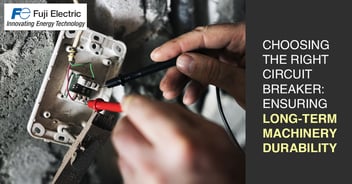Circuit Protection: The Backbone of Electrical System Reliability

Electrical engineers tasked with designing power distribution systems shoulder a significant responsibility. Their efforts significantly impact the effectiveness, output, and security of residential spaces, workplaces, and business establishments. The challenge lies in creating designs that are foolproof, offering protection against faults and overloads while ensuring the utmost safety for users. This blog explores the importance of circuit protection in electrical distribution system design, highlighting key goals and protective measures.
The Fundamental Goals of Electrical Distribution System Design:
Localizing and Isolating Faults: Electrical systems can encounter a variety of issues, including overloads, short circuits, and voltage fluctuations. The primary objective is to swiftly identify and isolate these faults to prevent extensive damage to the building and the grid.
Preventing Unnecessary Power Loss: Efficient power distribution systems should minimize power loss during normal operation and fault conditions. This not only saves energy but also ensures uninterrupted service.
Overcurrent Protection: The First Line of Defense
Overcurrent Protection Devices (OCPDs) serve as the initial defense against thermal overloads and faults. These devices, including circuit breakers, relays, and fuses, play a vital role in power system protection. They are engineered to break the electrical circuit when an excessive load or a sudden short circuit takes place.
- Fuses: Fuses are simple yet effective OCPDs. They comprise a slender wire with an Ampere rating surpassing the maximum allowable current. During overcurrent conditions, the fuse blows out, effectively isolating the circuit. However, fuses are irreversible and require manual replacement to restore operation.
- Thermal Magnetic Circuit Breakers: For reversible operation, thermal magnetic circuit breakers with long-time trip operations are used. When the current exceeds the rated threshold, these circuit breakers isolate the circuit. They will attempt to reclose after a delay, assuming the fault has cleared. If not, they repeat this process a set number of times before permanently opening, necessitating a manual reset.
Modern advancements allow digital control through relays, which can be operated via PLCs and microcontrollers. This enables precise control based on sensor data, promoting the concept of building automation. While this is more common in large-scale buildings, it offers enhanced protection and operational flexibility.
Ground-Fault Protection: A Critical Layer of Safety
Ground faults, especially arcing type faults, pose a unique challenge as they are harder to detect due to their lower magnitude. To address this, two types of ground-fault protection are employed:
- Ground-Fault Protection of Equipment: This protection aims to safeguard equipment by disconnecting it from damaging line-to-ground fault currents.
- Ground-Fault Circuit Interrupters (GFCIs): GFCIs are designed for personnel protection, detecting faults as low as 5mA. They play a crucial role in preventing electrical shocks and ensuring user safety.
Grounding is an essential aspect of power system protection. It involves intentionally connecting a current-carrying conductor to the ground, which helps limit voltage during lightning strikes and when conductors come into contact. The National Electrical Code (NEC) recommends multiple grounding points within a building to ensure redundancy in the protection scheme.
In addition to grounding and overcurrent protection, other equipment, such as arc-fault circuit interrupters and mechanical protection devices, may be integrated into the system. These are especially critical in scenarios like emergency power circuits in hospitals, where safety is paramount.
Undoubtedly, the significance of safeguarding electrical distribution systems through circuit protection cannot be emphasized enough. It is the cornerstone of ensuring the safety, reliability, and efficiency of electrical systems in both residential and commercial settings. Engineers must adhere to regulations and codes while leveraging modern technologies to create robust, fault-tolerant designs that protect both equipment and users.
 China
China Europe
Europe France
France Hong Kong
Hong Kong Indonesia
Indonesia Japan
Japan Singapore
Singapore Thailand
Thailand USA
USA
